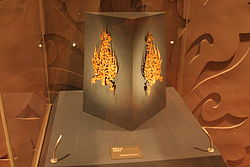Muryeong of Baekje
Muryeong of Baekje (462–523, r. 501–23), also known as Sama, was a 6th-century Korean king.[1] He was the 25th king of Baekje, which was one of the Three Kingdoms of Korea in ancient times.[2] The name Muryong means "military peace". It is a name he got after death.[1]
| Muryeong of Baekje | |
|---|---|
| Hangul | 무령왕, 무녕왕, 무영왕 |
| Hanja | 武寧王 |
| Revised Romanization | Muryeong-wang, Munyeong-wang, Muyeong-wang |
| McCune–Reischauer | Muryǒng-wang, Munyǒng-wang, Muyǒng-wang |
| Birth name | |
| Hangul | 사마, 여융 |
| Hanja | 斯摩, 餘隆 |
| Revised Romanization | Sama, Yeoyung |
| McCune–Reischauer | Sama, Yŏyung |
Events of Muryeong's reign
During Muryeong’s reign, the southwestern kingdom of Baekje was allied with its eastern rival Silla against the northern kingdom of Goguryeo.[3]
The king is known for expanding contacts with China and Japan.[4]
After his death
Muryeong's tomb is located in Gongju in South Chungcheong Province.[5] It has been studied by archeologists and historians.[2] This the only ancient tomb that has been positively identified among those of this period.[6]
Legacy
In 2001, Japan's Emperor Akihito acknowledged a distant relationship with Muryeong. He explained, "I, on my part, feel a certain kinship with Korea, given the fact that it is recorded in the Chronicles of Japan that the mother of Emperor Kammu was of the line of King Muryong of Baekje."[7]
Muryeong Of Baekje Media
Muryeong's crown in his tomb
References
- ↑ 1.0 1.1 Kim, Wongyong. (1986). Art and Archaeology of Ancient Korea, p. 194; retrieved 2011-12-25.
- ↑ 2.0 2.1 Korea Tourism Organization, "Songsan-ri Tombs and Royal Tomb of King Muryeong"[dead link]; retrieved 2011-12-25.
- ↑ Discover Korea, "Gongju’s Songsanri Tombs," 19 December 2008; retrieved 2011-12-25.
- ↑ Paxton, Norbert. (2005). The Rough Guide to Korea, p. 276.
- ↑ Gong ju City, Group of Ancient in Tombs Songsan-ri (Tomb of king Muryeong-wang)" Archived 2010-05-12 at the Wayback Machine; retrieved 2011-12-25.
- ↑ "Baekje Bone Fragments 'Belonged to King or Queen'," Chosun Ilbo (ROK). December 9, 2009; retrieved 2011-12-25.
- ↑ Watts, Jonathan. Guardian.co.uk "The emperor's new roots," The Guardian (UK). 28 December 2001; retrieved 2011-12-25.
More Reading
- Kim, Won-Yong. “The Tomb of King Muryong of the Paekche Dynasty.” Asian Pacific Quarterly of Cultural and Social Affairs (Seoul) 3:3 (Winter 1971): 34-46.
- Paik, Seung-gil. "Excavation of the Tomb of Paekche King Muryong." Korea Journal 11:8 (August 1971): 48-51.
Other websites
| Wikimedia Commons has media related to Lua error in Module:Commons_link at line 62: attempt to index field 'wikibase' (a nil value).. |
- http://www.myj7000.jp-biz.net/clan/03/03013.htm#003 Archived 2012-02-05 at the Wayback Machine


